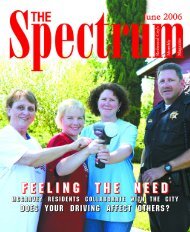TaekwonâGeremyâ - The Spectrum Magazine - Redwood City's ...
TaekwonâGeremyâ - The Spectrum Magazine - Redwood City's ...
TaekwonâGeremyâ - The Spectrum Magazine - Redwood City's ...
You also want an ePaper? Increase the reach of your titles
YUMPU automatically turns print PDFs into web optimized ePapers that Google loves.
Community Interest<br />
City Hires Assistant City Manager<br />
After a significant, in-depth recruiting process, <strong>Redwood</strong> City announced<br />
today the hiring of Ms. Audrey Ramberg as the city’s assistant city manager.<br />
Ramberg was most recently senior advisor and project leader for the County<br />
of San Mateo and brings with her a great deal of experience in the wideranging<br />
field of municipal management. She will start work in <strong>Redwood</strong> City<br />
on March 18.<br />
“I’m very pleased to welcome Audrey to <strong>Redwood</strong> City. I know she’ll<br />
excel as a crucial member of our executive team,” said City Manager Bob<br />
Bell. “Audrey offers <strong>Redwood</strong> City a wide range of experience and success<br />
in every aspect of municipal management and a great combination of skills,<br />
talent and knowledge. She beat out over 100 candidates in what was a very<br />
competitive process.”<br />
Ramberg has over 22 years of experience in public service and holds an<br />
M.B.A. from Stanford University as well as a B.A. in political science and<br />
economics from Duke University.<br />
“<strong>Redwood</strong> City is really an excellent fit with my experience and interests,<br />
and I believe I can bring a lot of value to the organization,” said Ramberg. “I<br />
want to work with people who thrive on continuous improvement, who take<br />
very seriously their commitment to the community and who are proud of the<br />
excellent services they provide — and that describes the people who work<br />
for <strong>Redwood</strong> City. I’m truly looking forward to joining the ongoing efforts of<br />
<strong>Redwood</strong> City as it moves forward in so many ways.”<br />
In addition to serving as a key resource for leading and facilitating strategic<br />
planning and citywide process improvement initiatives, in this newly created<br />
position Ramberg will oversee the city’s human resources and public information<br />
functions, along with the operations of the city manager’s office. She will also<br />
serve in the city manager’s absence.<br />
Prior to her most recent work with San Mateo County, Ramberg held a number<br />
of key positions in local government, including assistant city manager in Menlo<br />
Park, assistant to the city manager in Palo Alto and assistant to the San Mateo<br />
County manager. She has also worked in a high-level consulting capacity and was<br />
founder/director of Peninsula Partnership for Children, Youth and Families.<br />
Cañada College Introduces African Wasp<br />
to Help Control the Olive Fruit Fly<br />
significant portion of its history attached to or within a single host organism.<br />
<strong>The</strong> exploration took researchers to South Africa, Namibia, India, China and<br />
other countries. Scientists shipped a number of parasitoids to California and<br />
studied them in quarantine before identifying two — Psyttalia lounsburyi<br />
and Psyttalia humilis — that have been released throughout the state’s olive<br />
growing region. Both species were released at Cañada in 2010–11. “<strong>The</strong>se<br />
wasps are specialists,” Nieto said. “<strong>The</strong>y have co-evolved with the olive fruit<br />
fly and are well-suited to utilize the fruit fly larvae for reproduction.”<br />
<strong>The</strong> wasps are very small and look like little ants with wings. <strong>The</strong>y are<br />
also incapable of stinging people. And while they pose no threat to people or<br />
animals, they pose a major threat to olive fruit flies.<br />
Female wasps deposit eggs into a fruit fly maggot inside of an olive. <strong>The</strong><br />
egg hatches into a smaller larva that feeds internally on the maggot. After this maggot<br />
pupates, instead of a fly emerging, a wasp emerges to seek out additional maggots.<br />
Since the wasps were released on campus, Nieto and his students have been<br />
monitoring the progress of the little African wasp. “Cañada College is one<br />
of only two sites in the state where Psyttalia lounsburyi has been recovered<br />
for two consecutive years,” Nieto said. “This is encouraging, but several<br />
challenges exist and could still derail this project.”<br />
Nieto said the wasp population is dependent on the density of the fruit fly<br />
population so, as the fruit fly population shrinks, so do the densities of the wasps.<br />
“<strong>The</strong> wasps will not completely eliminate the pest,” he said. “Instead, our<br />
project strives to reduce the olive fruit fly population in regions outside of<br />
commercial production. That includes olive trees that are used for landscaping,<br />
located in preserved open space or in residential areas that are not managed<br />
and thereby act as a pest reservoir, capable of reinfesting commercial olive<br />
groves annually.”<br />
Cañada has partnered with UC Berkeley, UC Riverside, the California<br />
Department of Food and Agriculture and the United States Department of<br />
Agriculture on this project. A scientific paper describing the work will soon<br />
be submitted to the journal Environmental Entomology.<br />
<strong>The</strong> college also received funding from the San Mateo County Community<br />
College District Trustees Fund to help integrate the research into the Biology<br />
110 curriculum at Cañada.<br />
“Students collectively generate hypotheses, design experimental protocols,<br />
collect olives, rear out insects, graph results and write a paper describing the<br />
project,” Nieto said. “Having hundreds of these trees on campus provides<br />
instructors and students wonderful learning opportunities that are literally<br />
steps away from the classroom. While I’m still in the process of refining this<br />
curriculum, I think it’s a wonderful example of how undergraduate students<br />
can participate meaningfully in active research.”<br />
<strong>Redwood</strong> City Fire Department’s<br />
“Fire Protection Rating” Improves<br />
A small African wasp that is the natural enemy of the olive fruit fly appears<br />
to be gaining a toehold in the olive trees on the campus of Cañada College in<br />
<strong>Redwood</strong> City which could bring good news to California’s olive growers.<br />
Diego Nieto, an adjunct biology professor at the college, and students in<br />
Biology 110 are part of a statewide effort to find a way to control the olive<br />
fruit fly, whose larvae feed on the fruit of olive trees and is considered a serious<br />
pest. California produces more than 95 percent of the olives grown in the U.S.<br />
<strong>The</strong> olive fruit fly was first discovered in California in 1998 and was<br />
later found in San Mateo County in 2001. California is the only area in the<br />
Western Hemisphere where the olive fruit fly has been found. Scientists<br />
discovered that natural predators in California were largely ineffective in<br />
controlling the spread of the fruit fly.<br />
“<strong>The</strong> olive fruit fly is in the family Tephrididae, which is home to several<br />
serious agriculture pests, including the Mediterranean fruit fly, Mexican fruit<br />
fly and Oriental fruit fly,” said Nieto. “<strong>The</strong>se flies are capable of utilizing ripening fruit<br />
for oviposition, which makes them especially damaging to fruit production.<br />
<strong>The</strong> fruit flies we commonly encounter, on the other hand, are in the family<br />
Drosophilidae and are only capable of laying eggs in overripe fruit.”<br />
<strong>The</strong> widespread and rapid establishment of the olive fruit fly in California<br />
led to a worldwide search for parasitoids, an organism that spends a<br />
<strong>The</strong> <strong>Redwood</strong> City Fire Department announced that after extensive evaluation,<br />
its fire-protection services, as rated by an insurance industry advisory<br />
company, improved from a Class 3 to a Class 2.<br />
<strong>The</strong> classification by Insurance Services Office Inc. (ISO), known as the<br />
Public Protection Classification (PPC) program, assesses the fire-protection<br />
efforts in a particular community. <strong>The</strong> <strong>Redwood</strong> City Fire Department was<br />
graded on communications, water supply, operations, training, and fire<br />
prevention codes and programs. <strong>The</strong> department received an overall score of<br />
89.27 out of a possible 100 total points. This new rating places the department<br />
in the top 1 percent safest of all U.S. municipal rated fire departments.<br />
“Our recent evaluation indicates the commitment made by our City Council,<br />
city management, the <strong>Redwood</strong> City Water Division and San Mateo County’s<br />
public safety communications,” said Fire Chief James Skinner. “We are extremely<br />
proud and dedicated to be providing the best services to our community.”<br />
ISO collects information on municipal fire-protection efforts in<br />
communities throughout the United States. In each of those communities,<br />
ISO analyzes the relevant data using its Fire Suppression Rating Schedule (FSRS).<br />
<strong>The</strong> company then assigns a Public Protection Classification from 1 to 10.<br />
Class 1 generally represents superior property fire protection, and Class 10 indicates<br />
that the area’s fire-suppression program doesn’t meet ISO’s minimum criteria.<br />
By classifying communities’ ability to suppress fires, ISO helps the communities<br />
(continues on next page)<br />
<strong>The</strong> <strong>Spectrum</strong> 19
















